You have 0 product(s) in your cart.
Abyss Scuba Diving
Navigating Your First Dives: An Introduction To Basic Underwater Navigation Skills
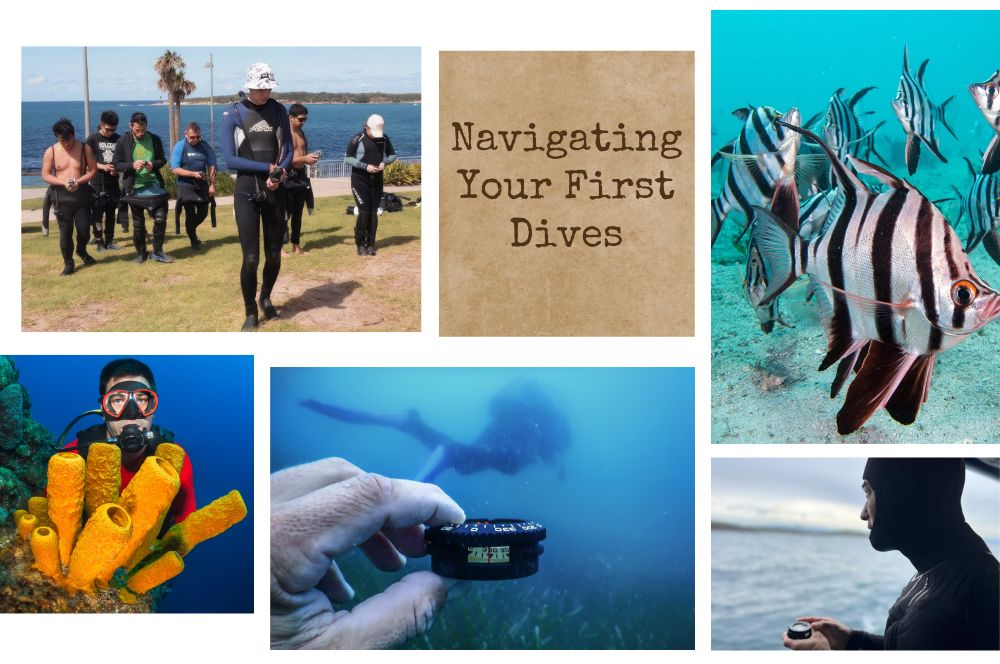
Navigating Your First Dives: An Introduction to Basic Underwater Navigation Skills
Imagine exploring the vibrant, mysterious underwater world, swimming through colourful corals and observing fascinating marine life. As a scuba diver, you know that mastering underwater navigation skills is crucial for enjoying these experiences safely and efficiently. In this blog post, we will dive deep into the world of underwater navigation, from the fundamentals taught in Open Water Diver courses to advanced techniques and navigation tips for new scuba divers that can help you become a more proficient diver. Ready to dive in?
Short Summary
-
Underwater navigation involves dive maps, briefings and natural/compass navigation skills to plan a safe dive.
-
Real-world applications of these techniques make diving safer and more enjoyable.
-
Preventive measures such as planning ahead and practising regularly are essential for successful underwater navigation.
Underwater Navigation Tips for New Scuba Divers
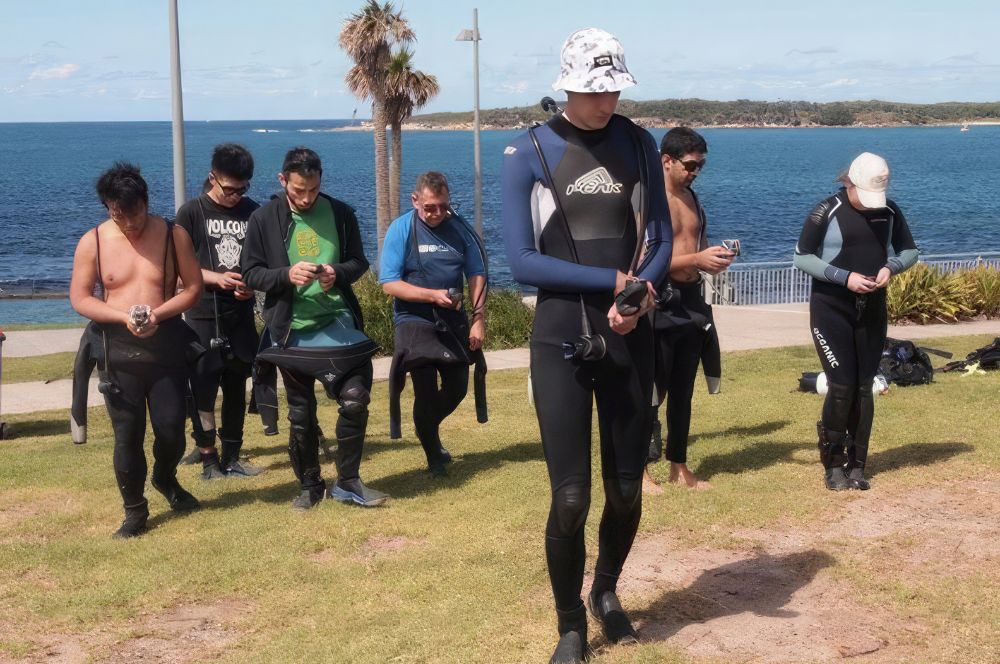
Navigating underwater might seem daunting at first, especially with limited visibility compared to dry land. But fear not! Scuba diving courses equip you with essential underwater navigation skills right from the beginning, including natural navigation and compass navigation. These skills are vital for a safe and successful dive.
Let’s explore the foundations of underwater navigation to understand better the importance of proper planning and the use of dive maps and briefings.
Recap of Open Water Diver Course Navigation Skills
You learned fundamental scuba skills during your Open Water Diver course, including simple underwater compass navigation. These navigation techniques covered in the course include natural navigation, compass navigation, distance estimation, and dive time management.
Even experienced divers can make common navigation errors, such as failing to take a bearing before diving or misunderstanding the dive compass. To avoid these mistakes, it’s crucial to practice and refine your navigation skills regularly.
Real-world Application
Underwater navigation skills are essential for recreational divers and crucial in scientific research, military operations, and operating autonomous underwater vehicles (AUVs). By applying navigation skills effectively in real-world diving situations, divers can confidently explore new dive sites, map out their dives, and return to their starting point.
This real-world application of navigation skills makes diving with a boat crew on a dive boat a safer and more enjoyable experience.
Dive Site Planning and Familiarization
Proper dive site planning and familiarization are crucial for ensuring safety and maximizing the likelihood of achieving your dive objectives. This includes assessing site conditions, identifying potential risks, and determining the most suitable entry and exit points.
Establishing a prearranged depth and time plan and utilizing the buddy system further contribute to a successful diving experience. The more you know about the location where you’re scuba diving, the better prepared you’ll be.
Dive Maps
Dive maps play a crucial role in underwater navigation, as they visually represent the dive site. These maps can be updated each time you visit a dive site, ensuring accuracy and helping you plan your dives more effectively.
You can navigate underwater with greater confidence and safety by using dive maps to pre-plan your dives, identify potential hazards, and pinpoint areas of interest.
Importance of Listening to Dive Briefings
A dive briefing is essential to scuba diving safety, providing critical information about the dive site, potential dangers, and emergency protocols. Paying close attention to dive briefings ensures that you are well informed about the dive site and any associated risks, allowing you to dive safely and responsibly.
Establishing clear expectations for the dive and adhering to safety protocols further enhance your diving experience. This includes understanding the dive plan, site, and potential hazards. Additionally, it is important to be aware of the dive team’s emergency protocols and follow them in an emergency.
Embracing Natural Navigation
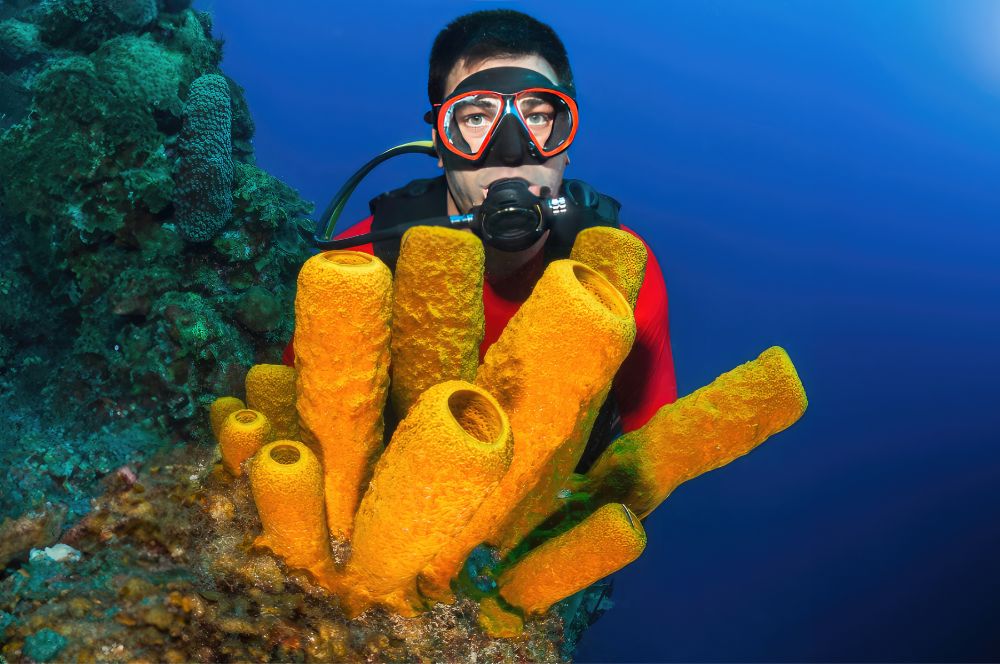
Natural navigation is a valuable skill for divers, as it involves observing and remembering details of your underwater surroundings and using them to navigate. This technique complements compass navigation and is often used in combination with it for more accurate and efficient underwater navigation.
Let’s dive into the world of natural navigation, including recognizing natural landmarks and employing various techniques to navigate underwater.
Understanding Natural Navigation

Natural navigation relies on your ability to recognize and remember distinct features in your underwater environment, such as the position of corals, the direction of currents, and the location of sunlight. Proficiency in natural navigation enables you to find your way back to the starting point without relying solely on a compass, making it a vital skill for any diver.
Navigation is an important part of diving, and natural navigation is a skill that can be developed with practice. It requires an understanding of the environment and the ability to recognize and remember features. With practice, divers can become proficient in natural navigation and use it to find their way.
Recognizing Natural Landmarks
Mastering the art of natural navigation is crucial for scuba divers, and recognizing underwater landmarks plays a significant role in this process. To help illustrate this concept, consider how effortlessly some people can navigate a shopping centre – much like my wife, who expertly finds her way around the three-dimensional space with ease. Similarly, divers should strive to become just as familiar with their underwater environment.
Natural landmarks such as striking rock formations, deep canyons, a uniquely coloured sponge, or even specific fish species that consistently remain in the same location (like the old wives at Oak Park) can serve as helpful reference points. By using these natural features, divers can navigate the underwater world more accurately and confidently.
Just as one would develop a mental map of a shopping centre, scuba divers should also create a mental map of the dive site using the natural landmarks they encounter. This essential skill will significantly improve a diver's ability to find their way and ensure a safe and enjoyable diving experience.
Techniques for Natural Navigation
Various techniques can be employed for natural navigation, such as following bottom features, using the sun’s position for orientation, and observing marine life behaviour. Practising these techniques in different dive sites will help you become adept at navigating underwater using natural landmarks and environmental cues.
This skill not only enhances your diving experience but also increases your safety by reducing the likelihood of becoming disoriented.
Mastering the Dive Compass
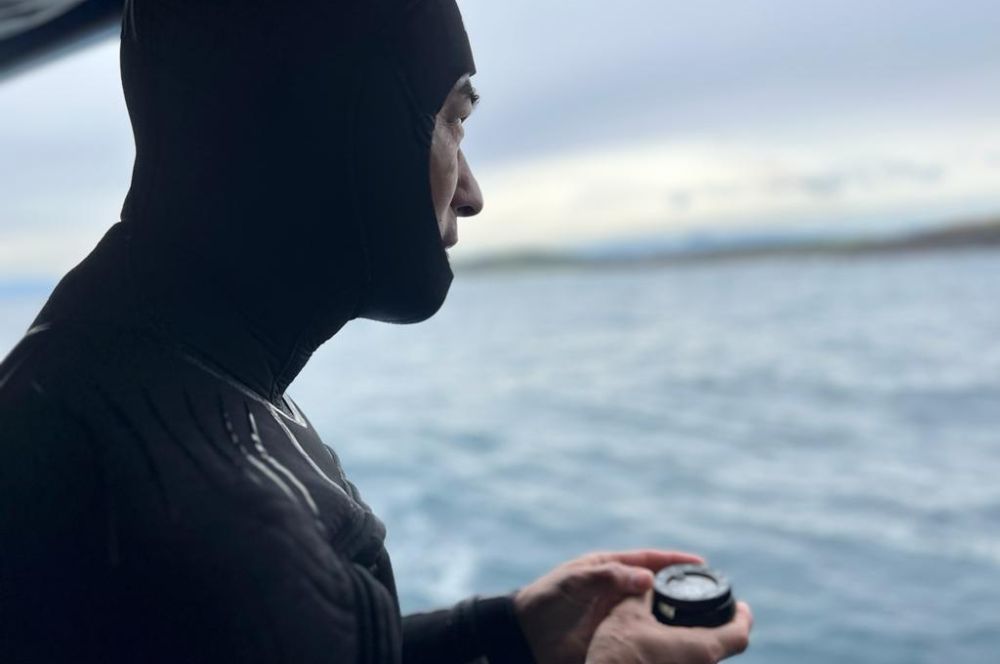
A dive compass is an essential tool for underwater navigation, especially when natural navigation is not feasible or visibility is limited. Understanding the components and functions of a dive compass is crucial for accurate and efficient navigation.
Let’s explore the importance of using a dive compass, its components, and how to practice compass navigation techniques.
Importance of Taking a Bearing Before Diving
Taking a compass bearing before diving is crucial for accurate navigation. This initial bearing helps you orient yourself underwater and determines the correct direction that you need to swim in to return to your starting point or reach your intended destination.
It also aids in refining your ability to move securely through the water and manage your air consumption.
Understanding the Dive Compass
A dive compass consists of a magnetized needle suspended in a liquid, which aligns itself with the Earth’s magnetic poles to indicate the direction of the magnetic north. The compass also features a lubber line, which is used with the north arrow to indicate your intended direction of travel.
By familiarizing yourself with the components and functions of a dive compass, you can navigate more accurately and confidently underwater with a compass's aid.
Steps for Compass Navigation
To use a compass for underwater navigation, start by holding the compass level and pointing the direction-of-travel arrow in your desired direction. Align the lubber line with the compass needle and proceed to hold the compass in that direction. By following these simple steps and regularly checking your compass, you can ensure that you stay on course and minimize the chances of becoming disoriented underwater.
Practice Exercises for Compass Use
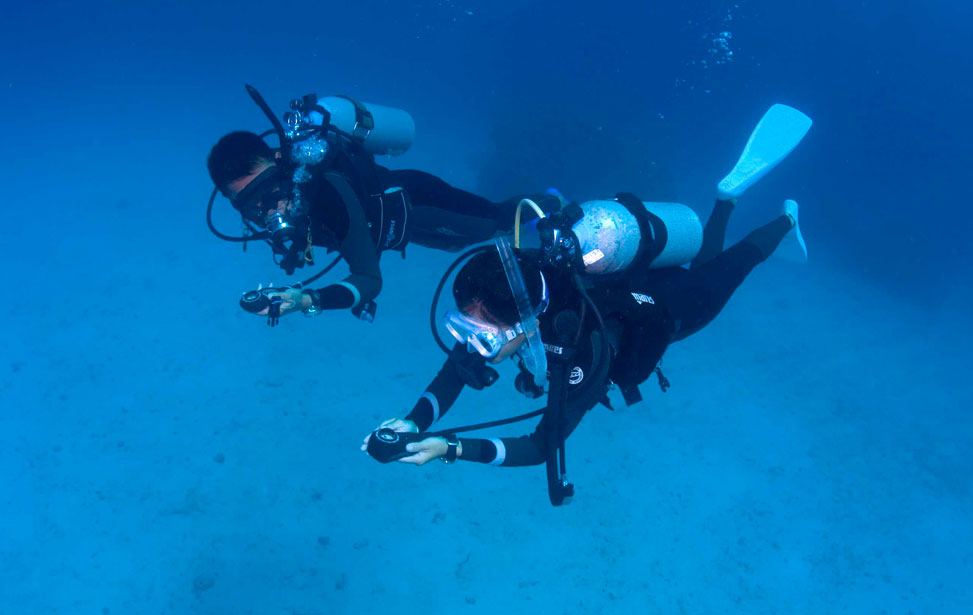
To improve your compass underwater navigation skills, practice exercises such as taking a bearing to a target, navigating to a target using a bearing, and navigating back to your starting point with a bearing. Regular practice will help you become more proficient in using a compass for underwater navigation and enhance your overall diving safety and enjoyment.
Distance Estimation and Dive Time Management
Estimating distance underwater and managing your dive time are crucial aspects of underwater navigation. These skills help you plan and execute safe and successful dives, as well as manage your air consumption and depth. Visibility underwater plays a significant role in these aspects, making it an important factor to consider.
Let’s explore various techniques for estimating distance underwater, managing dive time, and linking air consumption, depth, and dive time.
Techniques for Estimating Underwater Distance
Estimating distance underwater can be achieved through various methods, such as counting kick cycles, using a dive computer, and employing echo sounders. Practicing these techniques will help you develop a better understanding of the distance you’ve traveled underwater, making it easier to plan your dives and navigate back to your starting point.
By mastering these methods, you can become more confident in your underwater navigation and be better prepared for any unexpected situations.
The Role of Time Management in Navigation
Time management is essential for successful navigation because it enables you to plan and execute your dive more effectively. By managing the duration of your dive, you can ensure that you have sufficient air to complete the dive and return safely to the surface.
This skill is particularly important when exploring unfamiliar dive sites or when diving in challenging conditions.
Linking Air Consumption, Depth, and Dive Time
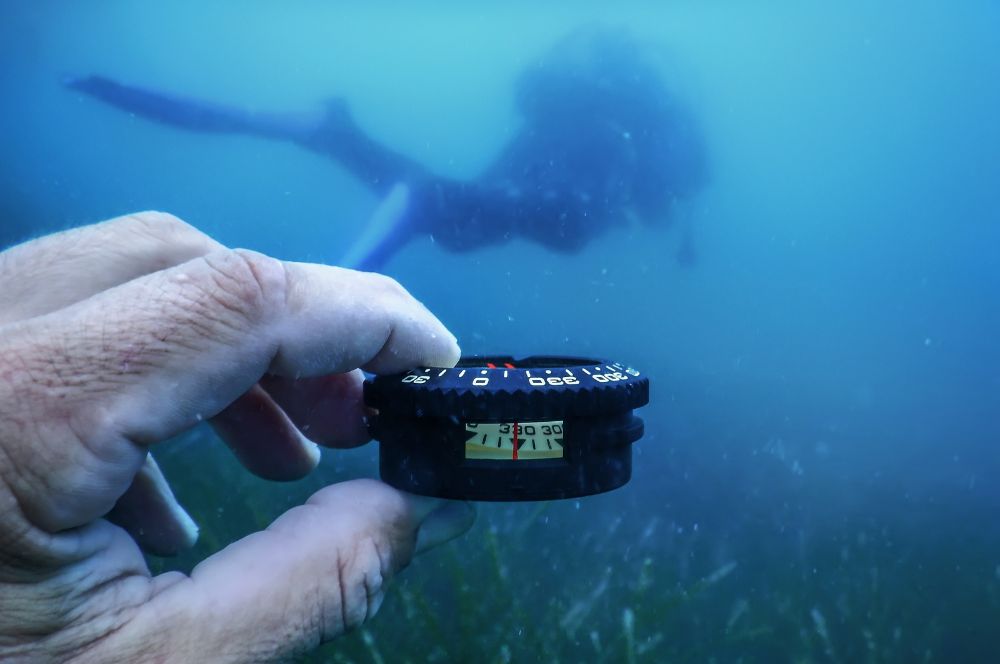
Understanding the relationship between air consumption, depth, and dive time is crucial for planning and executing safe and successful dives. As you descend deeper, the pressure increases, which in turn affects your air consumption and dive time. By taking these factors into account, you can better plan your dives and manage your air supply, ensuring a safe and enjoyable underwater experience.
It is important to understand the relationship between air consumption, depth, and dive time in order to plan and execute a safe and successful dive. Knowing how the pressure increases with depth can help you to better manage the pressure.
Advancing Your Navigation Techniques
As you become more experienced in underwater navigation, you can begin to explore advanced techniques such as reciprocal headings, navigation patterns, and creating your own marker buoy. These advanced techniques can further enhance your diving experiences and make you a more proficient navigator.
Let’s delve into these advanced navigation techniques and how they can benefit your diving adventures.
Reciprocal Headings and Navigation Patterns
Reciprocal headings refer to headings in the opposite direction of your original heading, while navigation patterns are predetermined routes used for underwater navigation. These advanced techniques can help you maintain your orientation, actively navigate, and return to your starting point more effectively, especially when visibility is limited or natural navigation aids are scarce.
Navigation patterns are predetermined routes used for underwater navigation. They can help you maintain your orientation and return to your starting point more easily, even when visibility is poor or natural navigation aids are scarce. Reciprocal headings are headings.
Keep Your Path Simple
Keeping your navigation path simple is crucial for successful diving. By adhering to a straightforward path, you can avoid becoming disoriented and ensure that you stay on course throughout your dive. Techniques such as following a line, using a compass, and relying on natural markers can help you maintain a simple and direct navigation path.
These techniques can help you stay on track and make sure that you don’t get lost. Additionally, they can help you plan your dive in advance.
Creating Your Own Marker Buoy
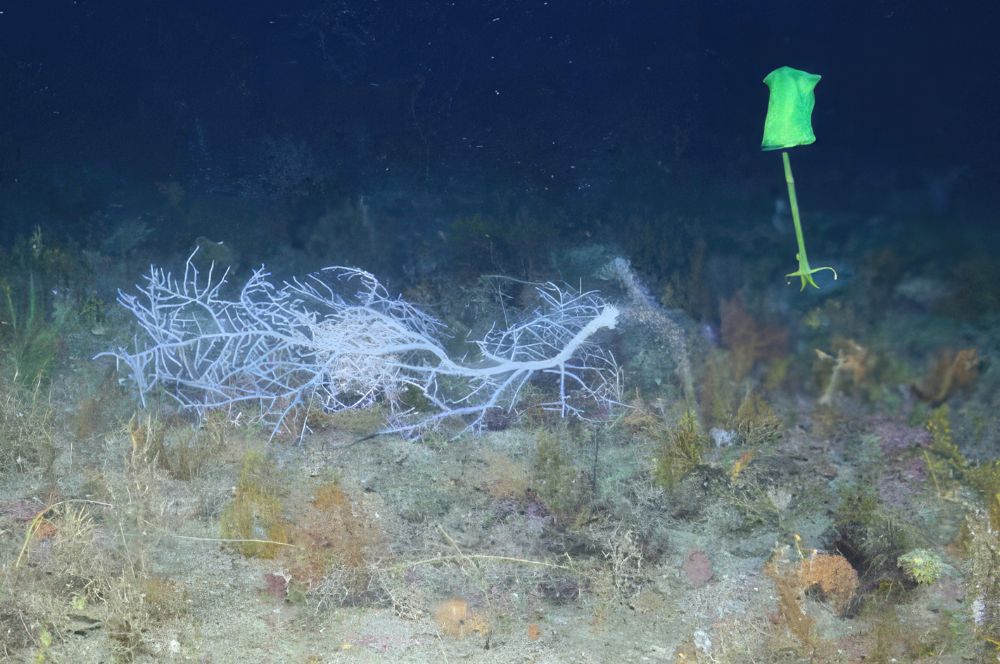
To make one, gather materials such as a brightly coloured pool noodle, rope or line, and a weight. Cut the noodle into 15 cm lengths and attach the rope and weight. Use the marker pen to write your name, contact information, date, and dive site location. Use the buoy during dives to mark exit points or other key navigational locations.
Use bright colours for visibility, ensure the rope length is appropriate, choose a suitable weight, and mark the buoy with your details. These steps will provide a reliable navigation tool to enhance safety and orientation during scuba dives.
Buddy System and Navigation
The buddy system is fundamental to scuba diving safety, ensuring that divers stay together and look out for one another throughout their dives. Effective communication and planning with your dive buddy are essential for successful navigation. Coordinating your movements and planning your route together can help guarantee a safe and enjoyable diving experience.
Communicating and Planning with Your Dive Buddy
Good communication and planning with your dive buddy are vital for successful navigation. This includes discussing your dive plan, sharing information about the dive site, and using underwater hand signals for communication.
Establishing trust and rapport with your dive buddy can ensure a safer and more enjoyable diving experience.
Avoiding Common Navigation Mistakes
Even experienced divers can make common navigation errors, such as the wrong direction, failing to take note of essential natural navigational features or not inspecting their compass regularly.
It’s important to be aware of these mistakes and implement solutions and preventive measures to ensure safe and successful dives.
Identifying Common Navigation Errors
Some of the most frequent navigation errors encountered in scuba diving include losing track of direction, misjudging distance, and not accounting for the influence of currents.
Being aware of these common mistakes can help you stay vigilant and avoid making them during your dives.
Solutions and Preventive Measures
To avoid common navigation mistakes, divers should pay attention to key natural navigation features, check their compasses frequently, and keep track of their direction. Additionally, planning your dive route in advance and practising navigation techniques regularly can help ensure a safe and enjoyable underwater experience.
Troubleshooting: What to Do If You Get Lost Underwater
Despite our best efforts and preparations, there may be instances when you become disoriented or lost underwater. Knowing how to stay calm and find your way back to the dive site is essential for your safety and the success of your dive.
It is important to remember that panicking underwater can be dangerous and can lead to further disorientation. Take a few deep breaths and assess the situation. Look for any landmarks that may help you.
Staying Calm
If you find yourself lost or disoriented underwater, remaining calm is crucial. Panicking can lead to impulsive behaviour, increased breathing, and hypoxia, all of which can be dangerous.
Focus on your breathing, visualize a peaceful environment, and remind yourself of safety procedures to help you stay composed and regain your bearings.
Finding Your Way Back
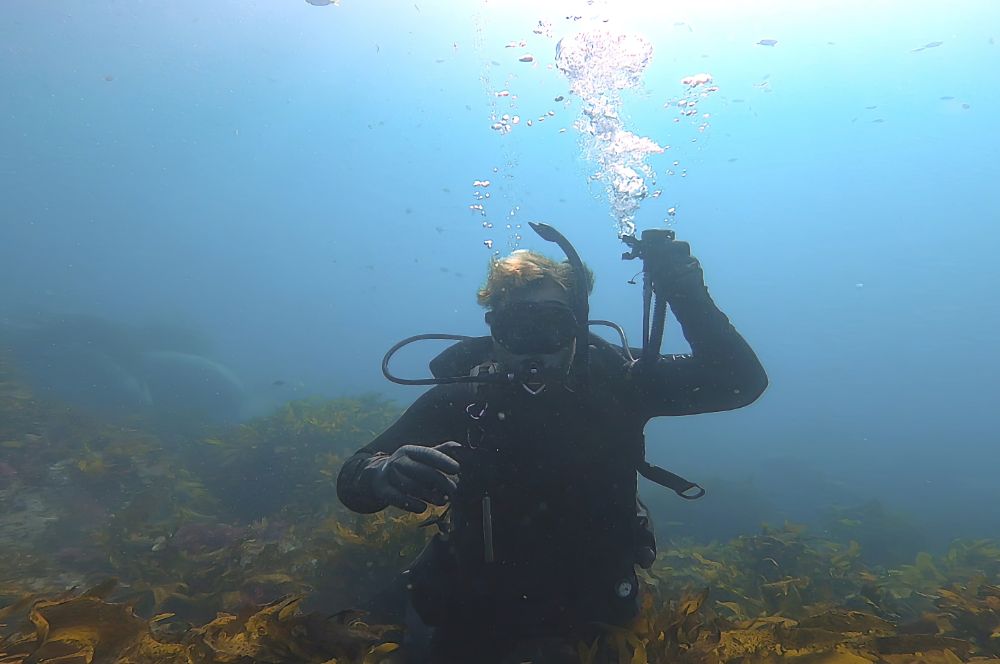
In the event that you become lost underwater, use natural landmarks or your compass to find your way back. By taking note of key natural features during your dive and checking your compass regularly, you can reorient yourself and safely return to the dive site.
Remember, practice makes perfect – the more you refine your underwater navigation skills, the better prepared you’ll be to handle unexpected situations.
Summary
In conclusion, mastering underwater navigation skills is essential for every scuba diver to ensure safety, efficiency, and enjoyment. By understanding the fundamentals of underwater navigation, embracing natural navigation techniques, mastering the dive compass, estimating distance and managing dive time, advancing your navigation techniques, and working effectively with your dive buddy, you can confidently explore the underwater world and create unforgettable diving experiences. So gear up, dive in, and let your underwater adventures begin!
Frequently Asked Questions
How do you navigate when scuba diving?
Navigating while scuba diving is an important skill to master and can be done through two methods. The first is natural navigation, which involves observing the bottom features of your surroundings to determine where you are and where you need to go.
Additionally, a compass can be used to maintain a bearing and ensure that you end up back at your point of origin. It is essential to maintain situational awareness and familiarize yourself with navigational techniques before going on a dive.
What is the 1/3 rule in scuba diving?
The 1-3 rule is an important guideline for safe diving that states that a diver should use only a third of their air supply to descend, another third to ascend and the last third to explore the dive site.
The ‘1-3 rule’ is an essential safety guideline in scuba diving that advises that one-third of a diver’s air supply should be used for descending, one-third for ascending, and the remaining third for any contingencies during the dive.
What should you do with your compass before your first dive?
To ensure a successful first dive, make sure to hold your underwater compass correctly and set the lubber line to point in your desired direction before descending. This will help you stay on course as you explore the depths of the ocean.
What makes underwater navigation challenging?
Underwater navigation is challenging for several reasons, including:
-
The lack of visual cues. We can use landmarks on land to help us navigate, such as buildings, trees, and other objects. Underwater, however, there is often very little to see, making it difficult to stay oriented.
-
The effects of water on magnetic fields. Compasses work by detecting the Earth's magnetic field. However, the water in the ocean can distort the magnetic field, making it difficult to get an accurate reading.
-
The currents. Currents can be strong underwater and easily move you off course. This can be especially challenging in areas with strong tidal currents.
-
The limited visibility. Visibility underwater can be very limited, especially in murky or turbid water. This makes it difficult to see your surroundings, and it can be easy to get lost.
What are the two primary techniques of underwater navigation?
Natural navigation and compass navigation are two primary techniques for successful underwater navigation.
These two techniques are used to help divers and other underwater explorers find their way around the ocean floor. Natural navigation relies on the environment to provide clues to navigation.
RELATED POSTS
-
Why You Should Always Make a Safety…
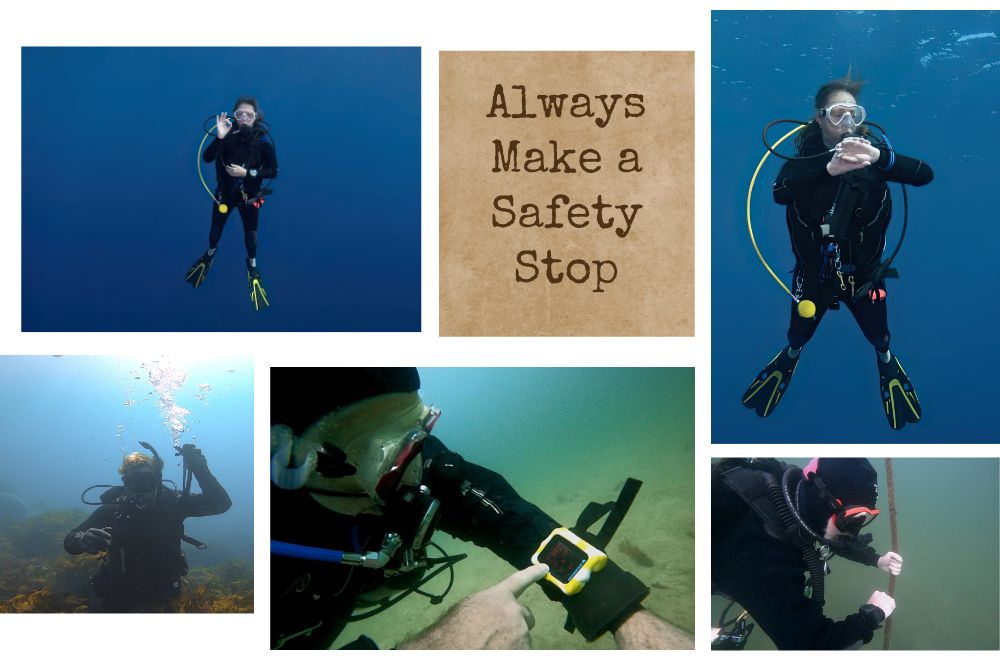
Why You Should Always…
Why You Should Always Make a Safety Stop Diving Imagine yourself submerged in the mesmerizing underwater […] -
Buoyancy Control: The Secret Ingredient…
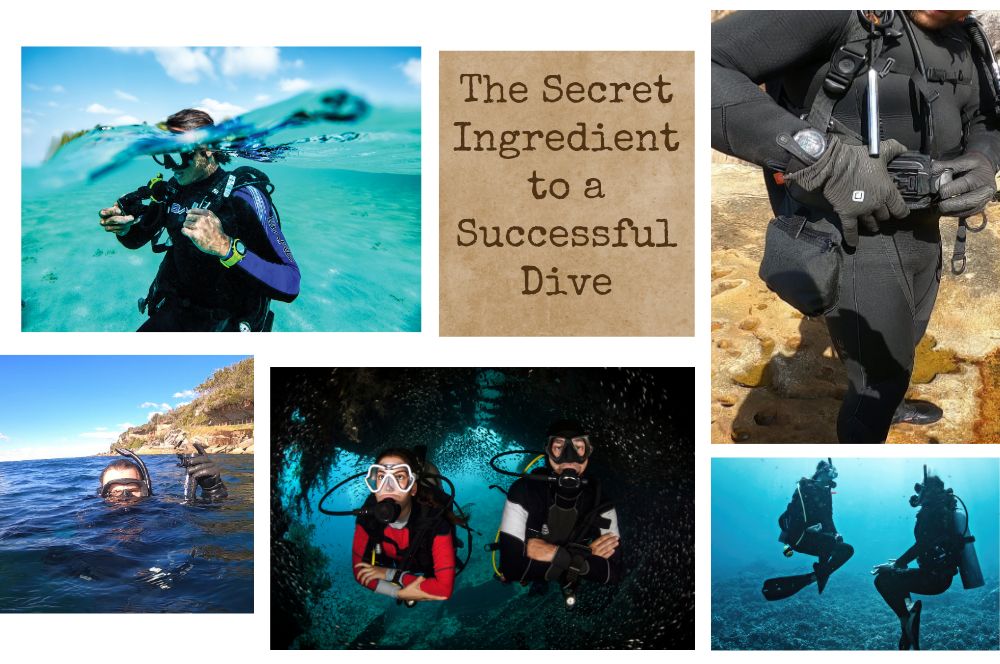
Buoyancy Control: The…
Buoyancy Control: The Secret Ingredient to a Successful Dive Imagine gliding effortlessly through the underwater […] -
How to put on Dive Fins
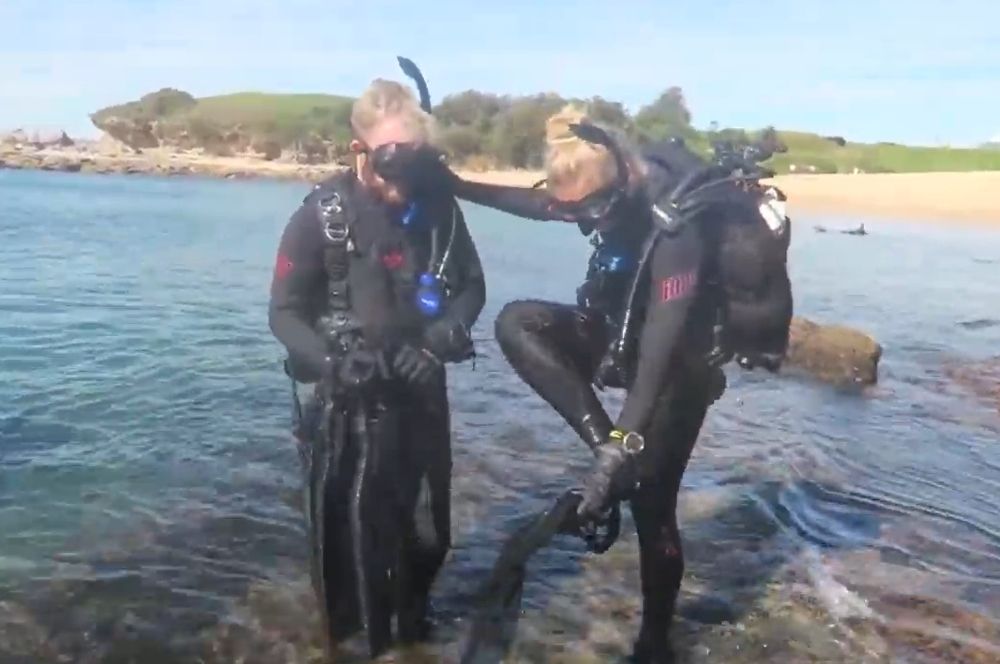
How to put on Dive…
How to put on Dive Fins Paying attention to the correct technique of putting on your fins is one of the most […] -
Bouyancy Control
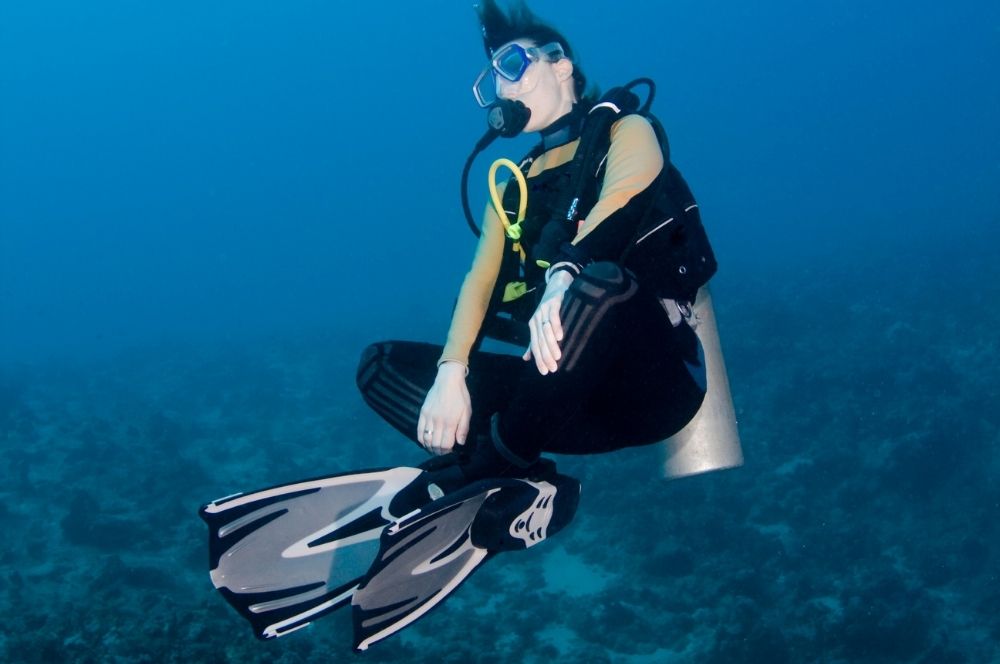
Bouyancy Control
Bouyancy Control Buoyancy control one of the most important skills to master as a scuba diver, and probably […]
Recent Posts





